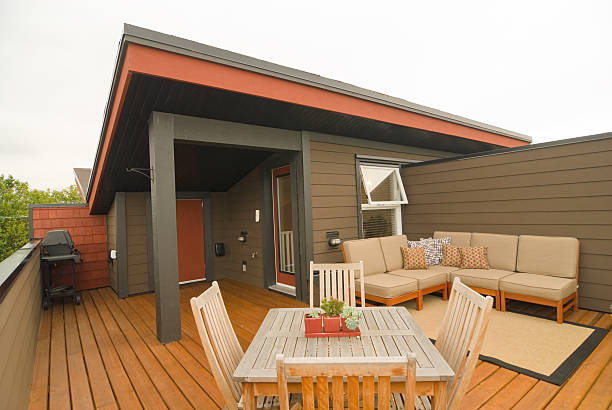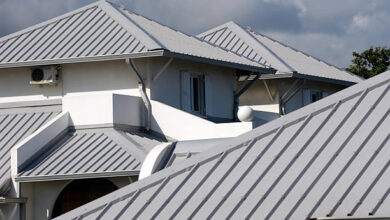How to Sand a Wood Deck Before Refinishing

When preparing an aging wood deck for refinishing, a thorough power washing or scrubbing with a brightener/cleaner is required. However, this process causes the wood fibers of the decking, steps, and railings to swell and lift away from the wood as they expand with the water. Splinters can be caused by wood fibers that are elevated after drying and remain high. As a result, sanding your wood deck lightly but completely is an essential step before staining or sealing it. Performing this critical step will ensure that your refinishing project produces excellent results.
Before You Begin
Follow the preparation instructions for the desired finished product. To start, apply a chemical brightener or cleaner on wood that has gone grey or has dark tannins. When cleaning your wood deck, you normally rinse it with pure water. Then sand the deck to remove the fuzzy wood fibers.
Use on ancient cedar or redwood. It may not be used on pressure-treated pine, fresh cedar, or redwood. To start, sand the fresh wood, then stain or lacquer it immediately.
You can buy hand-held orbital sanders or rent upright sanders from home improvement or rental stores, depending on your needs. Use one of these to sand your deck. Most individuals believe they can sand with a hand power sander, but patience is required, especially if the deck is large. Wood deck is mainly softwood. It’s vital to know. Softwoods dislike belt sanders, thus an oscillating or random orbit sander is usually preferable. Before sanding your wood deck, let it thoroughly dry. Wait a few days after a rain or a power washer to clean your residence. Sanding the deck and railings at varying speeds helps each section look its best.
Safety Considerations
Wear a particle mask and safety glasses while sanding, because wood dust can be dangerous to breathe in. Knee pads and hearing protectors will also make your job safer and more comfortable, so make sure you use them. A short-term allergic reaction or respiratory reaction, like an asthma attack, can happen even if you only come into contact with wood dust for a short time. A reaction to red cedar dust is more likely than dust from other types of wood.
What You’ll Need
Equipment / Tools
- Putty knife (if needed)
- Power washer (if needed)
- Scrub brush
- Bucket
- Screwgun (if needed)
- Breathing protection
- Eye protection
- Knee pads (optional)
- An oscillating or random-orbit sander
- Detail sander (if needed)
- Shop vacuum
Materials
- Deck brightener (if needed)
- Wood filler (if needed)
- Deck screws (if needed)
- Sandpaper (60- or 80-grit)
- Clean cloths
- Tack cloths
Instructions
Wash the Wood
Following the manufacturer’s instructions, thoroughly clean the wood deck. Use a sprayer setting that doesn’t harm the wood when power cleaning. It is important that you properly rinse the deck after using a brightener/cleaner in order to remove all chemical residue from the cleaner.
Inspect and Repair the Surfaces
Start by carefully inspecting all the surfaces you will sand—surface decking, edges, stairs, and railings. Make sure all fasteners are driven down below the surface of the wood. Some very old screws may need to be removed and replaced. Tighten screws that, over time, can raise slightly above the wood deck and get caught on the sander, and cause you to replace the sandpaper. If there are any loose boards, now is the time to drive new fasteners to secure them.
If there are splinters or deep gouges in the wood, make sure these are filled or repaired before you begin sanding. If using wood filler, make sure they are fully dry and hardened before you move on to sanding.
Sand the Decking Surface
Attach sandpaper with a 60- to 80-grit rating to your power sander and begin sanding. To avoid clogging the pores of the wood and preventing stains and sealants from entering, avoid using finer-grit sandpapers. Apply medium pressure to the sander as you sand the entire surface decking. Make sure the appearance is uniform as you progress. Cedar, redwood, and pressure-treated pine are all softwoods, and sanding them too hard can cause gouges and damage, so don’t go overboard.
Stair treads can be sanded using the same method. As soon as you’re done, use a shop vacuum to clean up the wood deck and stair treads.
Sand the Board Edges
If the railings have a very low bottom baluster rail, sanding the outer edges of the deck board may be a bit of a challenge. If your typical orbital sander won’t fit, consider using a smaller detail sander. It is important to make sure that the end grain of the decking boards is as smooth as possible before staining them, as stains can be absorbed differently depending on whether the end grain is smooth or not. Vacuum and then wipe down the boards’ edges to remove any loose dust.
Sand the Railings
Sanding your deck’s railing is critical because it is the most noticeable feature and the one on which onlookers like to fixate their gaze. In addition, a smooth railing is essential to eliminate splinters that could cause injury to the hands.
Make sure you sand all surfaces and cracks thoroughly with 80 to 100 grit sandpaper when working on railings. Again, don’t smooth out the surface to the point where the stain won’t penetrate; use a small detail sander or even just sand by hand.
Clean the railings thoroughly with a vacuum cleaner.
Vacuum the Entire Deck
Vacuum the wood deck one more time with a shop vac, and then wipe down the surfaces with tack cloths to remove any remaining sticking dust. Keep an eye out for cracks and fissures. This means that your deck is ready for staining or sealing, and you may begin. This should be done as soon as possible after sanding to avoid allowing the wood deck to get weathered or soiled. You should vacuum and wipe the wood deck with tack cloths again before applying stain or sealant if you have to wait.



